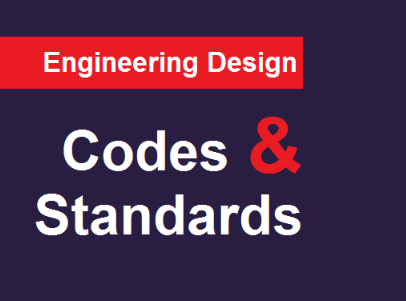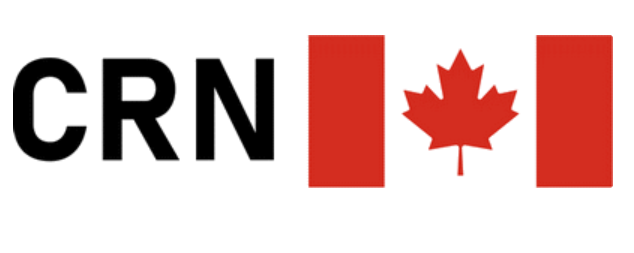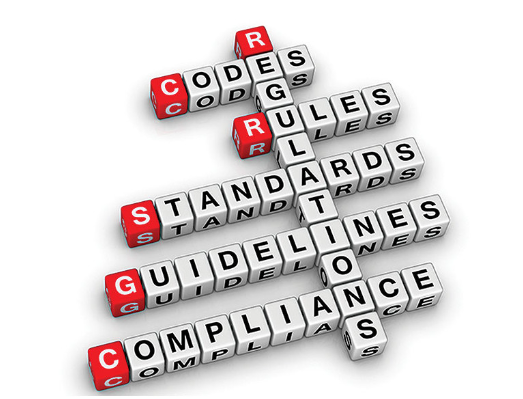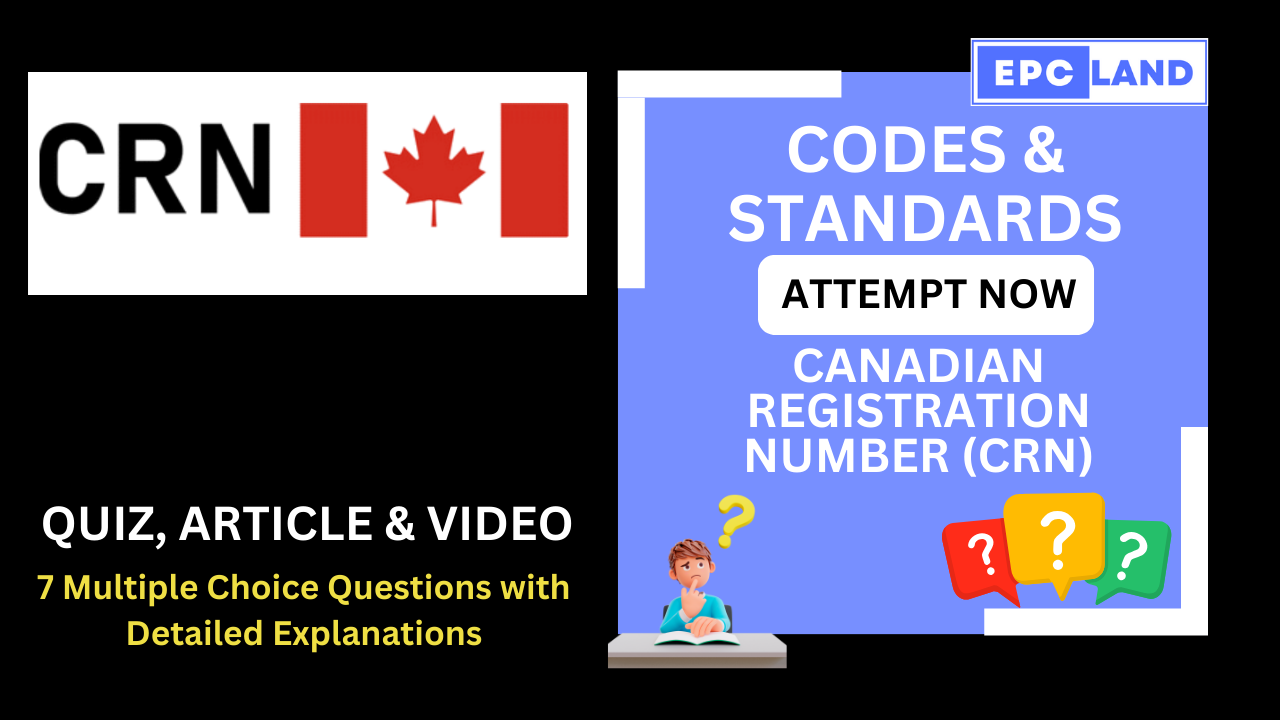

1. What does CRN stand for?
Choose the correct definition for CRN:
Explanation: The correct answer is B) Canadian Registration Number. The CRN is a unique number assigned to pressure equipment designs in Canada.
2. What does the first digit after the decimal point in the CRN signify?
Identify the meaning of the first digit after the decimal point in the CRN:
Explanation: The correct answer is C) Issuing province/territory code. The first digit after the decimal point in the CRN specifies the issuing province or territory.
3. Where is the CRN typically stamped on pressure equipment?
Identify the common location for the CRN (Canadian Registration Number) stamp on pressure equipment:
Explanation: The correct answer is C) On the nameplate of the equipment. The CRN is typically stamped on the nameplate for clear identification.
4. What is the significance of the CRN in terms of safety?
Choose the correct statement regarding the CRN’s significance for safety:
Explanation: The correct answer is B) It indicates compliance with safety standards. The CRN signifies that the equipment meets safety requirements.
5. How does the CRN contribute to trade and compliance?
Identify the role of the CRN in trade and compliance:
Explanation: The correct answer is C) It simplifies interprovincial movement of pressure equipment. The CRN facilitates trade by ensuring compliance.
6. Why do additional letters like “C” or “CL” appear in the CRN?
Identify the purpose of additional letters in the CRN:
Explanation: The correct answer is C) They indicate registration in all jurisdictions or all mandatory ones. Additional letters provide information about registration scope.
7. What benefits does the CRN offer for users of pressure equipment?
Choose the correct statement regarding the benefits of the CRN for users:
Explanation: The correct answer is C) It provides confidence in safety and reliability. The CRN assures users of the equipment’s safety and reliability.
25+ Relevant topics on Codes & Standards
Short Article on Codes & Standards


Demystifying the Canadian Registration Number (CRN)
The Canadian Registration Number (CRN) plays a crucial role in ensuring the safety and compliance of pressure equipment like boilers, pressure vessels, fittings, and piping systems across Canada. Here’s a breakdown of its key aspects:
What it is:
- A unique number assigned to a pressure equipment design by a specific province or territory in Canada.
- Indicates that the design meets the safety requirements of the applicable codes and regulations in that jurisdiction.
- Acts as a mark of approval for the equipment’s safe use.
Format:
- Consists of a letter, four digits, a decimal point, and up to ten additional digits and three letters.
- The first letter and four digits are unique to the issuing province or territory and follow a sequential numbering system.
- The first digit after the decimal point specifies the issuing province/territory: 1 – BC, 2 – AB, 3 – SK, etc.
- Additional letters like “C” or “CL” may be used to indicate registration in all jurisdictions or all mandatory ones, respectively.
Significance:
- Enhances safety by ensuring equipment adheres to established safety standards.
- Facilitates trade and compliance by simplifying interprovincial movement of pressure equipment.
- Provides clear identification of approved equipment for inspectors and users.
Where to find it:
- Stamped on the nameplate of the pressure equipment.
- Included in the equipment’s documentation and data report.
Benefits for users:
- Confidence in the safety and reliability of the equipment.
- Streamlined compliance with local regulations.
- Reduced risk of accidents and potential liabilities.
Overall, the Canadian Registration Number is a valuable tool that promotes safety, standardization, and efficient trade within the pressure equipment industry across Canada.
I hope this explanation clarifies your understanding of the CRN and its significance. Feel free to ask any further questions you may have!
Table of Contents
Don’t miss the Course on Effective Isometrics Management: Check Now
Enrollment Link
Recommended courses (Published on EPCLand)
- Complete Course on Piping Engineering
- Basics of Piping Engineering
- Piping Layout Engineering
- Piping Material Engineering
- Piping Stress Analysis
- Material Requisitions
- Piping Material Specifications
- Valve Material Specifications
- Plant Design & Layouts-OISD 118
- Isometric Management
Library of Technical Articles
Don’t miss out the collection of 15+ articles on following topics:
- Basics of Oil and Gas Industry
- Valves
- Testing
- Tank
- Piping Bulk Items
- Pipe
- Metallurgy
- Piping Materials
- Layout
- Instrumentation
- Heat Exchanger
- Type of Contracts
- Codes and Standards
- ASTM Standards
- Articles on Piping Specialty Items
Video details of Complete Course on Piping Engineering
Why Enroll in the EPCLand
Proven Track Record– PTR
Activities & Achievements before launching EPCLand
- Published more than 50+ short courses
- 3000+ Enrolments
- More than 3,500,00 Minutes of watch hours in the last 2 years
- 4000+ Students in 100+ Countries
- Rating of 4+ out of 5
- 1000+ YouTube Videos
- 8K+ Subscribers
What Students will Learn
- Codes & Standards of the Energy Sector
- Piping Material Engineering
- Piping Layout Engineering
- Stress Analysis
Interesting facts
- All the published courses have been developed by Industry Experts with more than 2 decades of experience
- Content is based on Practical experience and real-time problems.
- Content is designed and organized in such a manner that it can be easily grabbed.
- Complete website, Blogs and Quiz sections are Planned, Designed and published by myself (About me: Atul Singla)
- Complete flexibility of Time & Location, Students can access the content from anywhere & anytime
- Moreover, once enrolled, the content can be access as many times as you want, which helps in understand the fundamentals in a better way.
Conclusion
In conclusion, our courses are meticulously crafted by industry experts with over two decades of hands-on experience. The content is rooted in practical knowledge, addressing real-time problems. The material is thoughtfully designed and organized for easy comprehension. Every aspect, from the website to blogs and quizzes, has been planned, designed, and executed by Atul Singla, ensuring a comprehensive and seamless learning experience. With the flexibility of accessing the content at any time and from any location, students have the freedom to learn on their terms. Furthermore, enrollment grants unlimited access, allowing learners to revisit the material as often as needed, fostering a deep understanding of the fundamentals.



